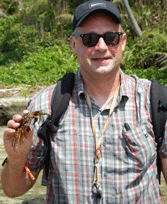Areas of Interest:
Matt's current areas of interest in geology include:
• A genetic and ore deposit model of the Bayan Obo REE-Fe-Nb mine in Inner Mongolia, China based on a comprehensive review of existing geochemical data (thesis near completioin; includes field study) Advisor: Professor Bor-ming Jahn.
• The tectonics of the Marianas Arc from Guam to Saipan as constrained by geochronology, geochemical evolution and structural history.
• Tertiary Volcanism and related plutons of the Western Cascade sub-province of SW Washington and Oregon, USA. Two abstracts and a publication on this research include: Curless, John M., Field, Cyrus W., and Vaughan, Matthew W., 1989, Hydrothermal Mineralization in the Vicinity of Rocky Top, Western Cascades, Oregon; GSA Abstracts with Programs, v. 21, no. 5, p.71 and Curless, J.M., Vaughan, M.W. and Field, C. W., 1990, Plutonism and Hydrothermal Mineralization associated with the Detroit Stock, Western Cascades, Oregon: GSA Abstracts with Programs, no. 3, p. 16. This paper was also printed in Oregon Geology, Volume 52, No. 6, November 1990, P. 137-138.
• Isotope geochemistry as a tool for constraining the mechanisms and evolution of the earth's crust as it relates to the likelihood of metalliferous deposit generation.
• Associations of elements and mineralogy related to REE, Au, Ag, Cu, Mo, Pb and Zn mineralization and their genetic relationships both spatially and chronologically. The application of these associations toward cost effective methods for locating metal concentrations.
• Application and understanding of structural geology as it pertains to source rock permeability/metasomatism and host rock mineralization, alteration plus fluid control.
• Understanding of macroeconomic cycles and the allocation of capital in the mining sector; Leading indicators of failures and wild success.
Geologic Experience:
Carlin Trend, Central Nevada, USA: Subsequent to undergraduate studies, I worked with Atlas Precious Metals as an Exploration Geologist. The experience led me all over the state of Nevada and SE Oregon. In Central Nevada, the Roberts Mountains are the result/expression of the Late Devonian to Early Mississippian Antler Orogeny; the first orogenic event to effect the cordilleran margin of Laurentia. The resulting Roberts Mountain Thrust is a regional feature which juxtaposes coeval Cambrian to Devonian silliclastic rocks atop an autochthonous series of miogeosynclinal or shallow water carbonate rocks. The displacement of the Roberts Mountain Thrust Fault across different sections of Nevada ranges anywhere from 60 to 120 miles of eastward movement depending on location. At Atlas Precious Metals our focus was on the sequence of upper plate Ordovician to Devonian dolomites and lime mudstones that underwent Oligocene to Miocene Basin and Range extension and epithermal mineralization. The igneous rocks affiliated with this extension are believed (by some) to be the heat engine responsible driving meteoric and connate waters as the primary agent of alteration and mineralization. At the Gold Bar and Gold Bar II properties, Au concentration is associated with a cap of highly silicified limestone over which were anomalous concentrations of Hg, As and Sb. Following the silicified zones to depth, a gradation from silicification to de-calcification of limestones results in a clay-like residiuum of deeply iron stained altered limestone. Duties at Altlas included:
• Exploration for geochemical anomalies using fundemental geologic methods to define structures, stratigraphy and alteration with mapping to define areas of likely precious metal deposition/concentration.
• Application of geobotanical prospecting techniques with subsequent assays and mapping to define localized anomalies of Hg, As, Sb, Cu, Pb, Zn, Ag and Au.
• Execution of a regional geophysical exploration program performing gravity measurements and density contrast modeling to locate buried horsts in basins filled by quaternary sediments. These blocks were in areas of likely Au mineralization and often in close proximity to existing Au properties in production. The results of these surveys led to the drilling of likely shallow blocks to test our hypothesis and results.
• Reconnaissance mapping and soil / sediment sampling.
• Staking/filing mining claims in rapid sequence to prevent encroachment with supervision of subsequent boundary surveys and infilling of claim staking errors.
• Execution, supervision and logging of reverse circulation and diamond drill core activity on the Gold Bar II and Gold Ridge properties.
Western Cascades subprovince, Oregon, USA: The Cascade Range of Western North America is a North-South trending magmatic arc that extends roughly 1100 km from Mt. Garibaldi in SW British Columbia to Mt. Lassen in Northern California. The Cascade Range is the result of convergence of the North American and Juan De Fuca plates. In Oregon, the Cascade Range is divided into two parallel physiographic provinces: The older Western Cascades which range in age from late Eocene to late Miocene in age and the younger High Cascasdes which range in age from late Miocene to present. The High Cascades are positioned east of the Western Cascades. The High Cascades are a 20 km to 30 km wide graben bound series of basaltic sheild volcanoes that range in age from 5 to 8 Ma topped by a series of prominent andesitic stratovolcanoes, most of which are younger than 3 Ma in age. The Western Cascades are composed of series of basaltic to rhyolitic volcanic flows, pyroclastics and sedimentary rocks derived from numerous volcanic centers. Western Cascade rocks are spacially and temporally associated with granodioritic plutons from which they were derived. Folded by a series of NE trending anticlines and synclines, the volcanic strata are faulted by regional NW trending structures, uplifted and deeply disected by streams and the effects of past glaciation.The Western Cascades host a proven porphyry Cu deposit and abundant signs of epithermal Au mineralization within and adjacent to the field study area of my undergraduate thesis near Detroit, Oregon.
Blue Mountain Province, Eastern Oregon, USA: The Blue Mountain Province of Eastern Oregon is a diverse accretionary terraine of Paleozoic to Mesozoic metasediments and metavolcanic rocks capped by Tertiary volcanics. My early training as a geologist includes Oregon State University's Geologic Field Camp in the Cretaceous Mitchell Inlier. This area is capped by Tertiary Clarno and John Day Volcanics then the mostly Miocene Columbia River Basalt Group.
